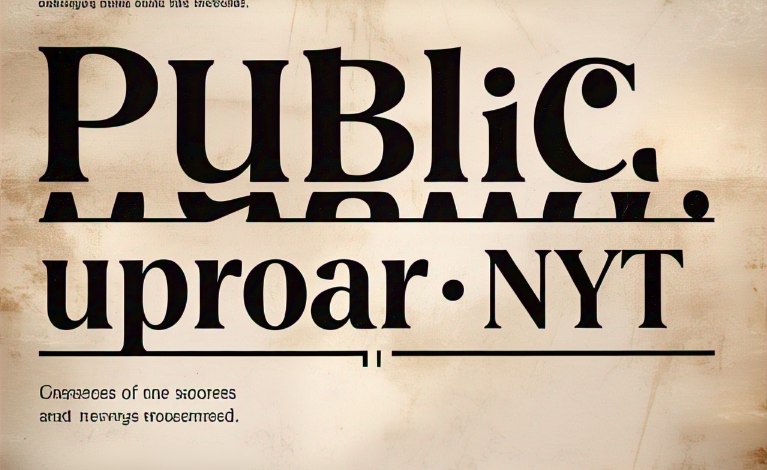Public Uproar NYT: What’s Behind the Growing Outrage

Public uproar NYT has been making headlines lately as more and more people express their dissatisfaction with certain issues. The New York Times has reported a noticeable increase in public outcry over recent events, and it seems like everyone is talking about it. Whether it’s politics, social issues, or controversial statements, this public uproar has caught the attention of many.
But why is there so much noise? The public uproar NYT is covering often reflects a deep frustration with the current state of affairs. From online debates to street protests, people are no longer staying silent. In this blog post, we’ll explore what’s causing this surge in public anger and how it’s shaping the national conversation.
Table of Contents
Why is Public Uproar NYT Trending Right Now
Public uproar NYT has recently been a topic that many people are talking about. News stories about public outrage are appearing everywhere. It seems like people are upset about a wide variety of issues, and the media, including The New York Times, is covering these events more than ever. But what is making public uproar so important right now? Let’s take a look.
One reason for the rise in public uproar is the power of social media. Platforms like Twitter and Facebook give everyone a voice. When something upsetting happens, it doesn’t take long before the public starts reacting, sometimes causing a storm of opinions. The New York Times is one of the sources that often report on these public outcries, helping to shape the ongoing conversation.
Another factor contributing to the uproar is the growing frustration with political and social issues. Whether it’s an unfair policy or a controversial statement, the public isn’t staying silent. People are increasingly speaking out against what they see as wrong, and the media is right there to capture it.
Public uproar NYT is trending because it reflects the current mood of society. The world feels more connected than ever, and that connectivity brings both good and bad. As people unite to share their opinions, the public outcry becomes an important part of shaping national discussions.
The Causes Behind the Public Uproar NYT Talks About
There are many reasons why we are seeing such a large public uproar NYT often covers. Some of these reasons are new, while others have been building up for a long time. Understanding these causes can help us see why people are reacting the way they are.
Political Decisions Spark Public Uproar
One of the main reasons for public uproar is politics. Many political decisions make people angry or upset. When laws are made or changed that affect everyday lives, it’s no surprise when the public reacts. Whether it’s an unfair law, a controversial statement from a leader, or a decision that hurts a community, these events often lead to public outrage. This is exactly the kind of story The New York Times reports on, shining a spotlight on what’s happening in the political world.
Social Issues Fuel Public Anger
Social issues also contribute to public uproar. Issues like racism, inequality, and injustice can bring people to the streets in protest. When communities feel that they are being treated unfairly, they often demand change. The NYT has covered many of these situations, helping to explain why people are upset and what can be done to improve things.
Media’s Role in Growing Public Uproar
Another cause of public uproar is how the media handles sensitive stories. The way news outlets, like the New York Times, report on an event can influence how the public feels about it. Sometimes, media coverage can cause even more anger by focusing too much on the negative aspects of a story. On the other hand, it can also encourage people to take action and stand up for what they believe in.
How Public Uproar NYT is Changing the Way We Think About Social Issues
The rise of public uproar NYT has led many people to think differently about social issues. As more people react to these events, it pushes society to rethink old ideas and consider new solutions. These public reactions are changing the way we approach challenges like poverty, racism, and the environment.
Highlighting Voices that Were Previously Silent
Public uproar often gives a voice to people who may not have been heard before. Whether it’s a protest, a social media campaign, or a news story, people are coming together to speak up. The New York Times has played a big role in highlighting these voices, showing how powerful it can be when the public stands united.
Creating Space for Important Conversations
Another way public uproar is shifting our thinking is by sparking important conversations. As people express their anger or frustration, it encourages others to think more deeply about the issues at hand. These discussions, whether online or in the media, help bring awareness to topics that may have been ignored before. The NYT helps keep these conversations alive, ensuring that the public’s concerns are not overlooked.
Shaping Public Policy and Change
Public uproar can also lead to actual changes in policy and laws. When a large number of people stand up for something, lawmakers often have to pay attention. This is why public uproar is so powerful—it can drive real-world change. The New York Times covers these shifts in policy and often helps people understand what’s happening behind the scenes.
The Impact of Public Uproar NYT: How Does It Affect Society
The impact of public uproar NYT reports on extends far beyond just headlines. It has real effects on society, influencing everything from laws and policies to how we treat one another. Understanding the effects of public uproar is important if we want to understand how society is evolving.
Raising Awareness on Key Issues
One of the biggest effects of public uproar is raising awareness on important topics. When an issue gains public attention, it often leads to more discussions, which can bring about changes. The New York Times has reported on many of these issues, helping to shed light on what needs to change in society.
Bringing People Together for a Common Cause
Another impact of public uproar is that it brings people together. Whether through protests, online petitions, or community groups, people unite around shared concerns. This unity can lead to stronger movements that demand attention and action. The NYT has covered these moments of unity, showing how people can come together for a cause.
Challenging the Status Quo
Public uproar often challenges the status quo, questioning long-standing practices or beliefs. When people speak out against something, it forces others to rethink what they believe to be true. This can lead to positive change, as society is pushed to grow and improve. The New York Times plays a role in challenging these ideas by covering stories that force us to examine the world around us.
The Role of Public Uproar in Shaping Future News
Public uproar NYT has proven to be more than just a trend in the news. It plays a key role in shaping how the news is reported and how society reacts to different events. As people become more vocal and active in sharing their opinions, the media responds by providing deeper coverage on the topics that matter most. The public’s voice is heard louder than ever before, and this will continue to influence how the media shapes the future of news and public discourse. Understanding this will help us engage more meaningfully with important issues.
Conclusion
In conclusion, public uproar NYT has become an important part of today’s conversations. People are more vocal than ever about the issues that matter to them, and the media, including The New York Times, plays a big role in bringing these issues to light. Whether it’s politics, social justice, or other concerns, public outcry is something we can’t ignore.
As society continues to change, public uproar will likely keep growing. It’s important to pay attention to what’s happening and understand why people are upset. By doing so, we can work towards a better future where everyone’s voice is heard and respected.
FAQs
Q: What is public uproar NYT?
A: Public uproar NYT refers to the widespread outrage or anger that is reported by The New York Times, usually about political, social, or cultural issues.
Q: Why is public uproar happening more today?
A: Public uproar is happening more today because people are more connected through social media, allowing them to express their opinions and frustrations quickly.
Q: How does public uproar affect society?
A: Public uproar can lead to important discussions, changes in laws or policies, and it helps raise awareness about social issues that need attention.
Q: Can public uproar lead to real change?
A: Yes, public uproar can lead to real change by encouraging lawmakers and leaders to address the concerns of the public.
Q: Why is The New York Times reporting on public uproar?
A: The New York Times reports on public uproar to help inform the public, raise awareness about key issues, and give voice to people’s concerns.





